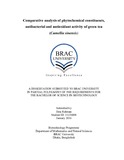| dc.contributor.advisor | Chowdhury, Ms. Jebunnesa | |
| dc.contributor.author | Rahman, Ilma | |
| dc.date.accessioned | 2016-12-01T07:36:49Z | |
| dc.date.available | 2016-12-01T07:36:49Z | |
| dc.date.copyright | 2016 | |
| dc.date.issued | 2016-01 | |
| dc.identifier.other | ID 11236008 | |
| dc.identifier.uri | http://hdl.handle.net/10361/7050 | |
| dc.description | This Thesis is submitted in partial fulfillment of the requirements for the degree of Bachelor of Science in Biotechnology, 2016. | en_US |
| dc.description | Cataloged from PDF version of thesis report. | |
| dc.description | Includes bibliographical references (page 66-74). | |
| dc.description.abstract | Camellia sinensis, the tea plant belongs to the Theaceae family. Tea industry is the second highest foreign exchange earner in Bangladesh. Increased consumption of green tea is due to its antioxidant properties. Research suggests green tea also possesses medicinal properties including antimicrobial, antifungal, and anticarcinogenic activities. Hence, this study was carried out using locally produced organic green tea. Preliminary screening of the extracts was conducted to identify the presence of alkaloids, flavonoids, steroids, saponins, tannins, phenols, cardiac glycosides and gums. Comparative analysis of the antimicrobial activity of the extracts was investigated against Escherichia coli, Enterotoxigenic Escherichia coli (ETEC), Shigella flexneri, Methicillin-resistant Staphylococcus aureus (MRSA) and Staphylococcus aureus. Ampicillin, ciprofloxacin and cefoxitin discs were used as positive control to measure the antimicrobial activity and synergistic activity of tea extracts and antibiotics. It was observed that repeated subculturing had changed the virulence pattern of MRSA to a sensitive strain. S. aureus alone exhibited sensitivity to all tested concentrations of each extract. Methanolic and ethanolic extracts showed highest activity index in all test strains. Aqueous extract had inhibitory effect only on S. aureus. Extracts did not demonstrate synergisitic activity with any of the drugs. Antioxidant activity of extracts was determined by DPPH free radical scavenging activity. Ethanolic extract showed the highest antioxidant activity followed by methanolic and aqueous extract. It is expected that the antimicrobial activities and presence of metabolites identified in this study will serve as a pivotal ground for further research regarding the many medicinal attributes of green tea. | en_US |
| dc.description.statementofresponsibility | Ilma Rahman | |
| dc.format.extent | 74 pages | |
| dc.language.iso | en | en_US |
| dc.publisher | BRAC University | en_US |
| dc.rights | BRAC University thesis are protected by copyright. They may be viewed from this source for any purpose, but reproduction or distribution in any format is prohibited without written permission. | |
| dc.subject | Biotechnology | en_US |
| dc.subject | Mathematics and Natural Sciences | en_US |
| dc.subject | Green tea | en_US |
| dc.title | Comparative analysis of phytochemical constituents, antibacterial and antioxidant activity of green tea : camellia sinensis | en_US |
| dc.type | Thesis | en_US |
| dc.contributor.department | Department of Mathematics and Natural Sciences, BRAC University | |
| dc.description.degree | B. Biotechnology | |

